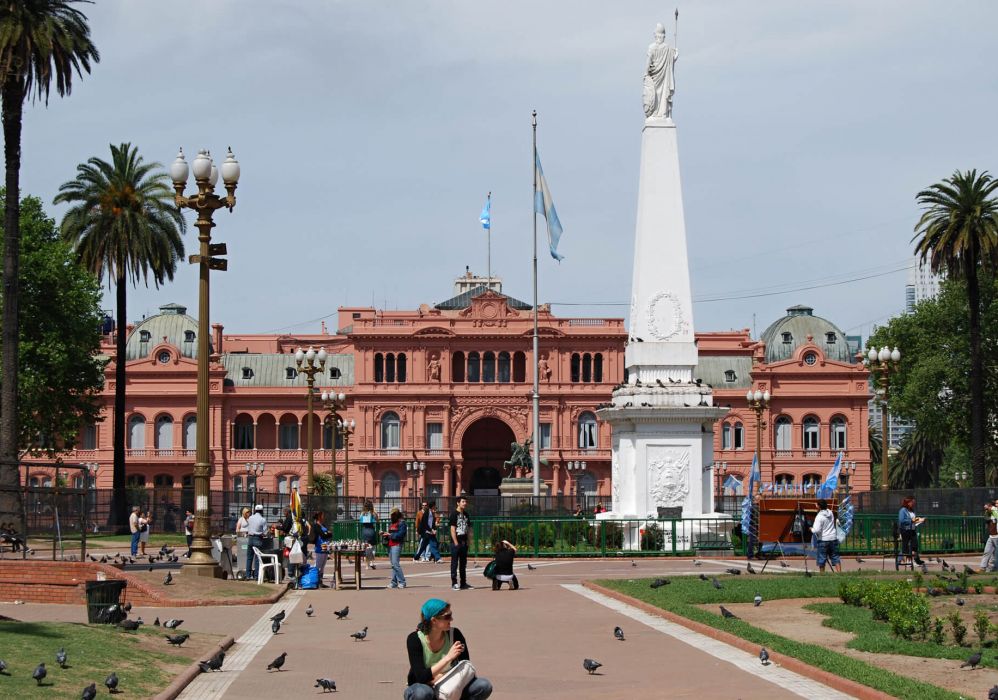
South America, Azamara Pursuit
At sea, off the coast of Argentina
We flew out of Auckland on Sunday night, March 1st, with Air New Zealand, on their direct flight to Buenos Aires, it would have to be the smoothest flight we have had in years, arriving at 4pm on Sunday afternoon, in our hotel by 5.30 pm close to the historic centre of Buenos Aires. First impressions on the drive in, a city of tenement buildings in various states of disrepair, only changing to commercial office blocks and high rise apartments when we dropped off the freeway and into the city centre. The hotel was sited next to the locks that formed the old port, the whole area since rejuvenated into expensive real estate, just a stones throw from the presidential palace. A sandwich, and a glass of very fine Argentinean Malbec saw us close out the day, but not before I reflected on how little we actually knew about the countries and ports that we would be visiting over the next 3 weeks on the ship.
Monday, March 2nd, Buenos Aires..
We were joining the ship in the afternoon and found there was a 3 hour guided tour from the hotel available that morning, it was to be our only opportunity to get a feel for the city as the ship was to sail at 5pm and we had to be on board by 3. Our guide was excellent and from her we started to learn some of Argentinas history, our first stop the Plaza de Mayo, the political heart of Argentina, a large open square in front of the Presidential Palace with a monument marking the founding of the nation on May 25th 1810 when Argentina declared its revolution against the Spanish, gaining independence in 1816. It is around this monument the “the mothers of the disappeared” still gather every Thursday to remind the nation of those lost and not accounted for under the military dictatorship that ruled Argentina from 1976 until 1983. The paving stones have inlaid headscarves in a circle around the monument in recognition of these women.
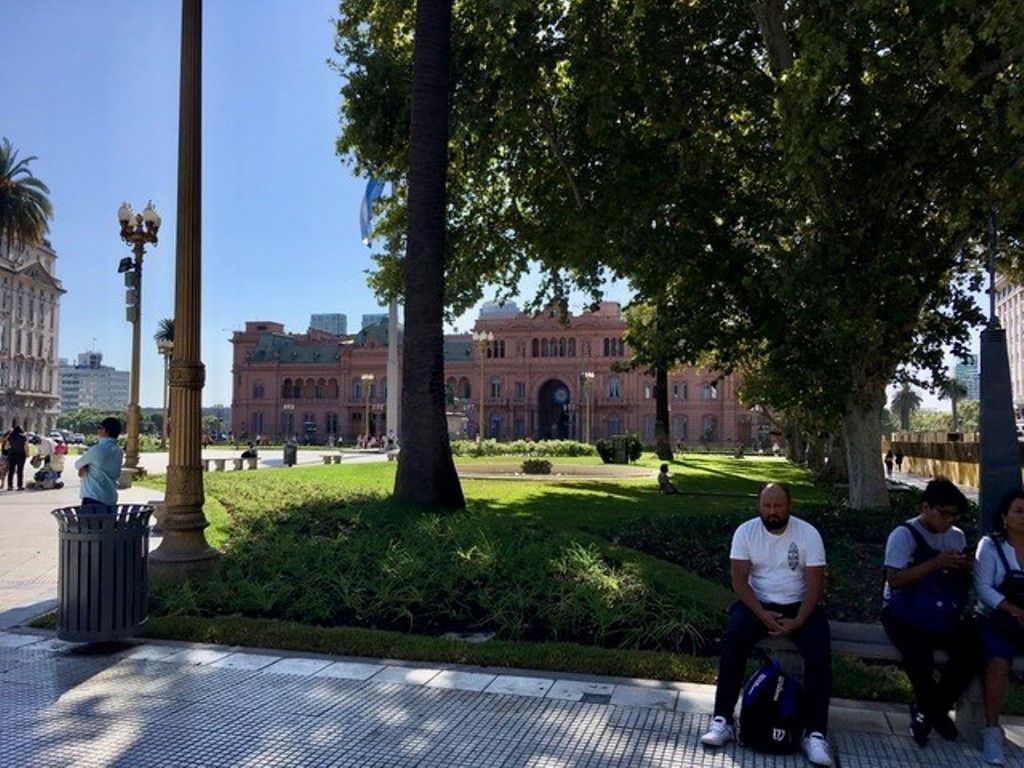
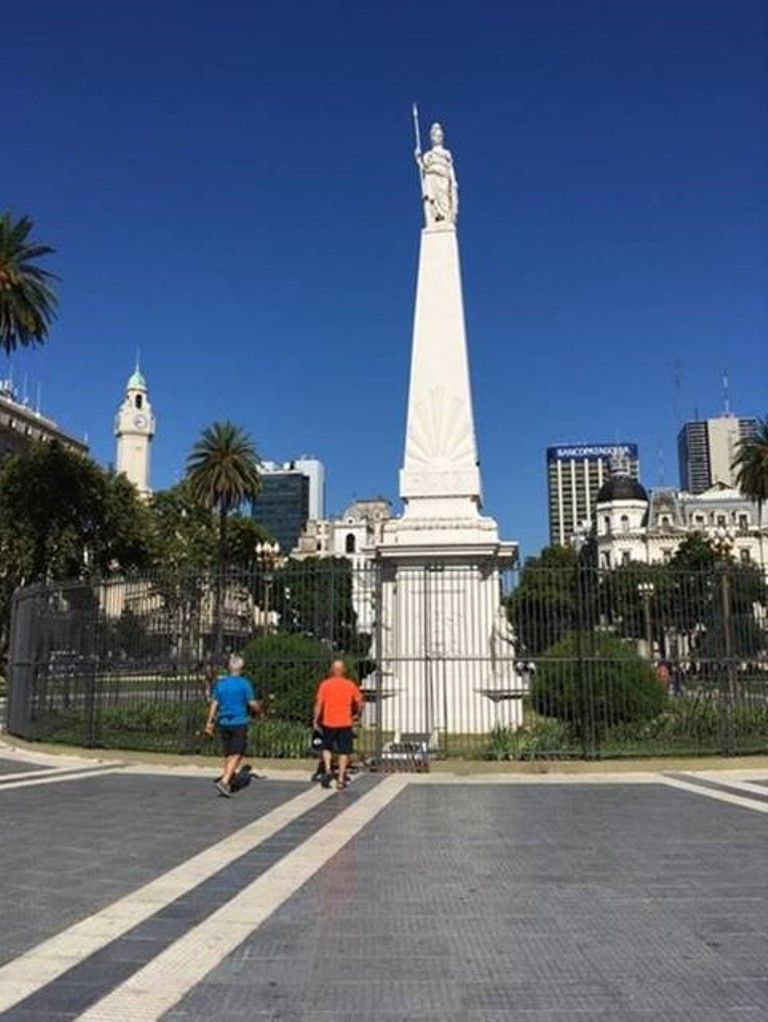
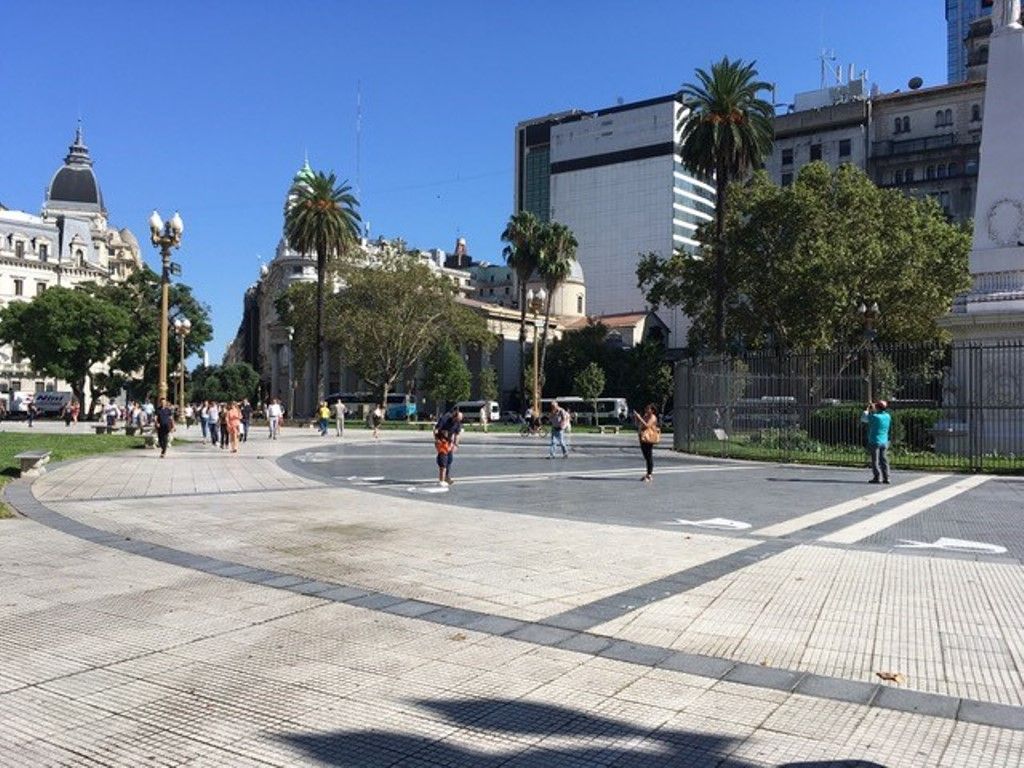 Our guide was very open about the horrors of this period of state terrorism and despite the return to democracy in 1983 she told us that corruption is still rife in Argentina and that the politics of the nation were incredibly complex. It was from the balcony of the Presidential Palace, the Case Rosada, the pink building in the first photo,( purportedly painted with ox blood mixed into white paint) that Juan and Eva Peron would address the nation, and to this day the square remains as the site for political protest.
Our guide was very open about the horrors of this period of state terrorism and despite the return to democracy in 1983 she told us that corruption is still rife in Argentina and that the politics of the nation were incredibly complex. It was from the balcony of the Presidential Palace, the Case Rosada, the pink building in the first photo,( purportedly painted with ox blood mixed into white paint) that Juan and Eva Peron would address the nation, and to this day the square remains as the site for political protest.
Buenos Aires is a city of 4 million people, and when combined with the adjoining municipalities the population swells to 9 million.
Argentina is second only to Brazil in land size in South America, and has a total population of 45 million.
Our next stop was in the neighbourhood of La Boca, the birthplace of the Tango, the home of the football team, the Boca Juniors and an area of what was poorer immigrant housing. Close to the original port of Buenos Aires the locals evidently would scrounge paint from visiting ships to paint their dwellings, the colourful tradition has carried on and the area is a tourist mecca of restaurants, tango performances and street art, funky and fun.
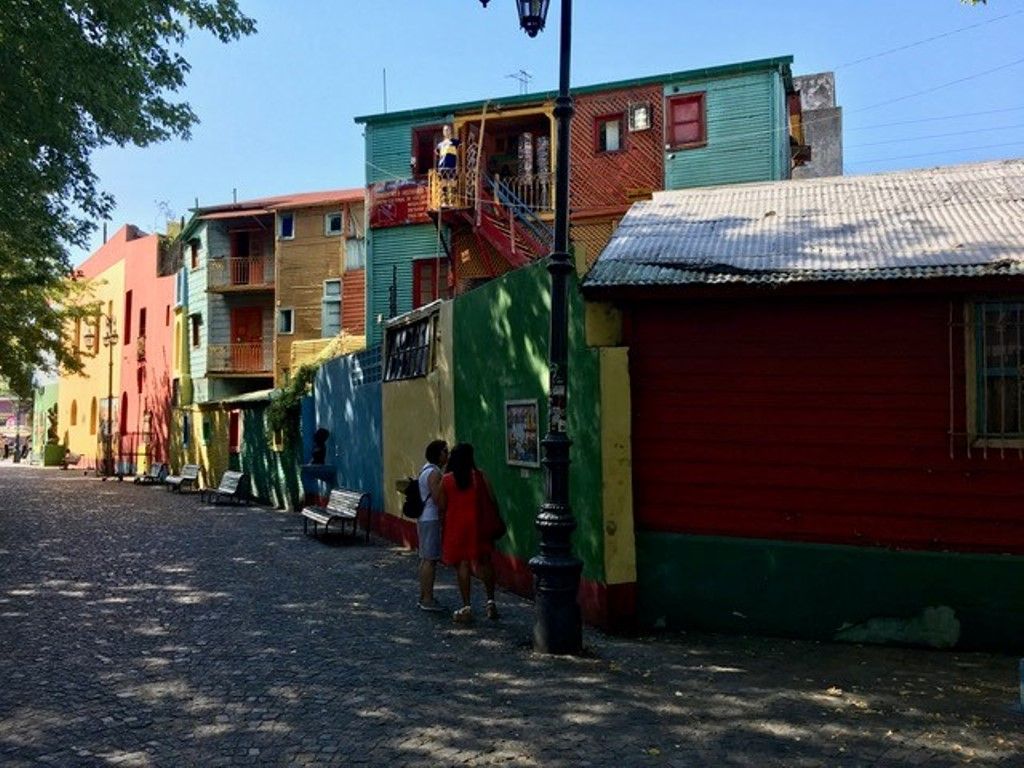
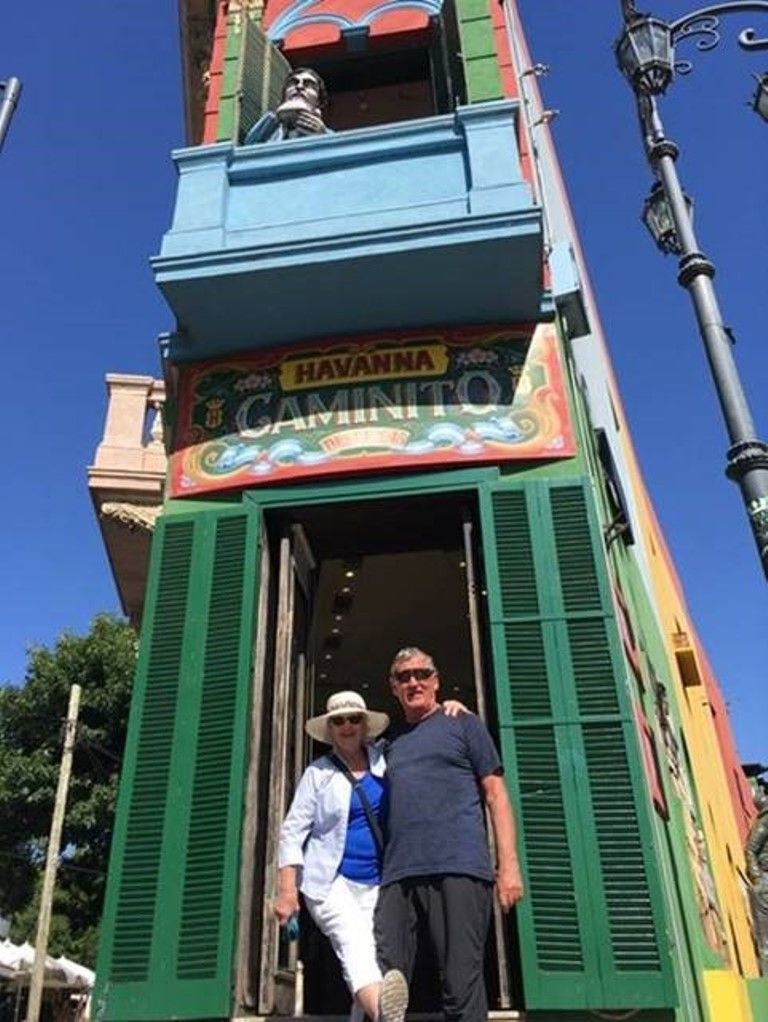
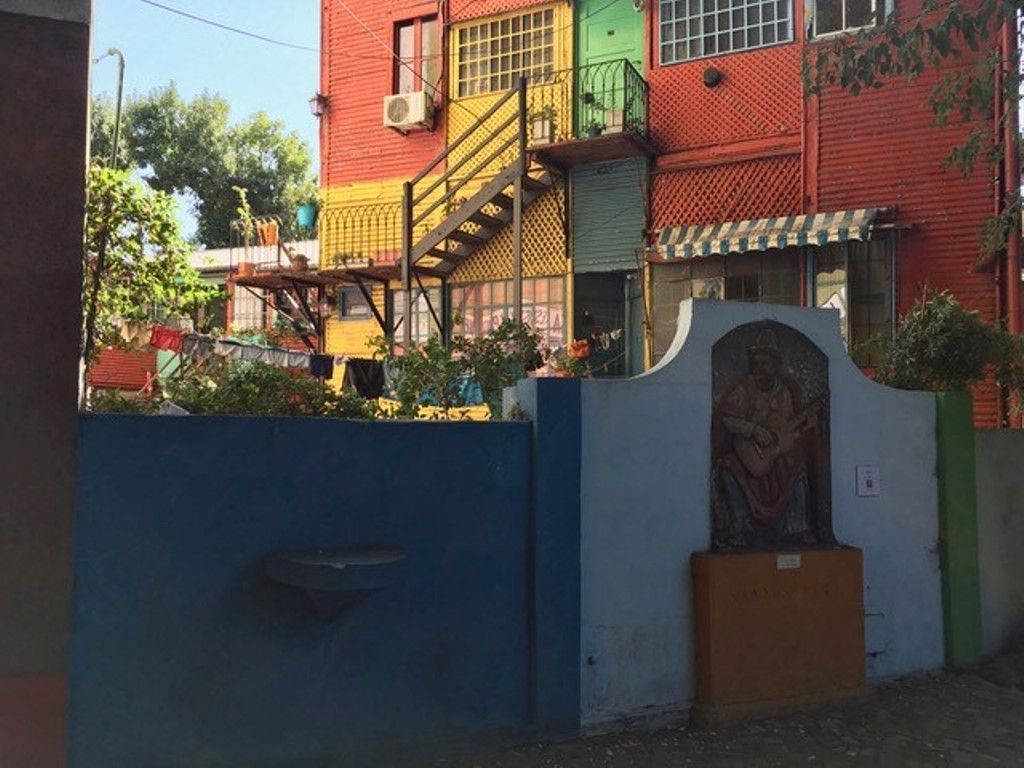 Our final stop was the cemetery at Recoleta, a virtual city of the dead where the wealthy and famous have their family mausoleums, 4900 of them, many still in use, with coffins in view through the glass fronted doors, with the stairways down to the underground vaults, some of which have their own chapels. It is also the last resting place of Eva Peron, she lies 5 metres underground in the family vault. Our guide recommended that if we wanted to know more and were interested in the story of what happened to her from the time of her death in 1952 at the age of 39 until 1976 when she was finally placed in the mausoleum, then search the subject on Google, ” Eva Perons body”, its a BBC.com account and an interesting snapshot of the intrigue surrounding the Perons and the Military during the period leading up to the coup d’etat in 1976, a coup that evidently had the backing and involvement of the US with Henry Kissinger evidently playing a role in advising the Argentinean Military, according to Dr Google.
Our final stop was the cemetery at Recoleta, a virtual city of the dead where the wealthy and famous have their family mausoleums, 4900 of them, many still in use, with coffins in view through the glass fronted doors, with the stairways down to the underground vaults, some of which have their own chapels. It is also the last resting place of Eva Peron, she lies 5 metres underground in the family vault. Our guide recommended that if we wanted to know more and were interested in the story of what happened to her from the time of her death in 1952 at the age of 39 until 1976 when she was finally placed in the mausoleum, then search the subject on Google, ” Eva Perons body”, its a BBC.com account and an interesting snapshot of the intrigue surrounding the Perons and the Military during the period leading up to the coup d’etat in 1976, a coup that evidently had the backing and involvement of the US with Henry Kissinger evidently playing a role in advising the Argentinean Military, according to Dr Google.
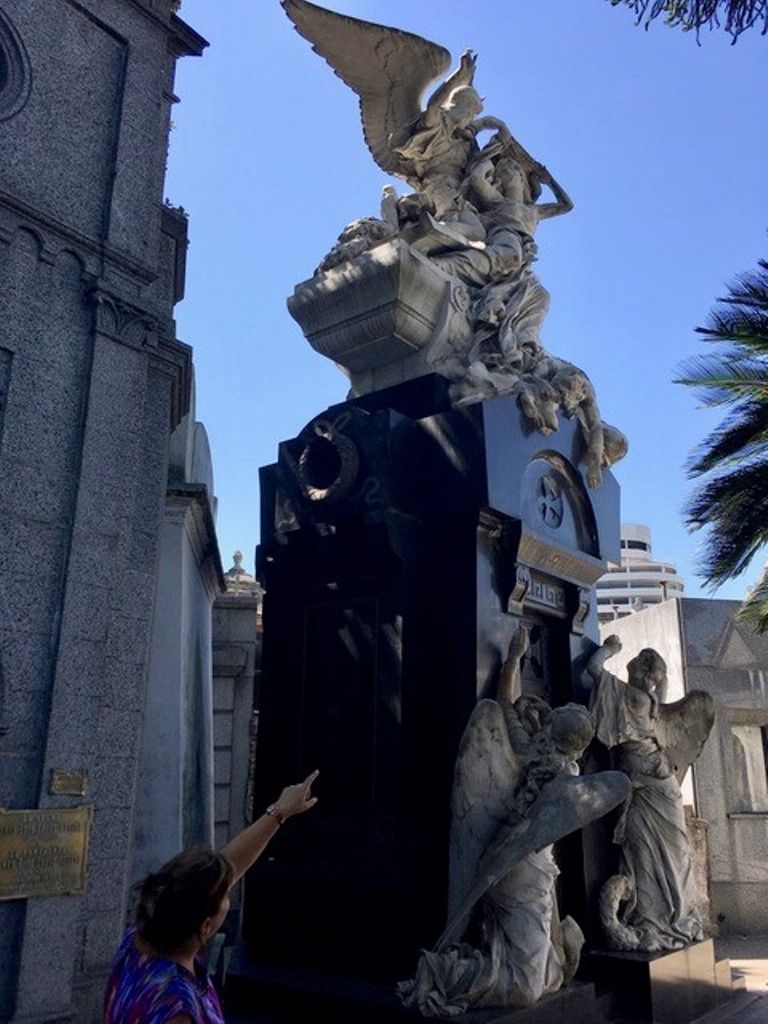
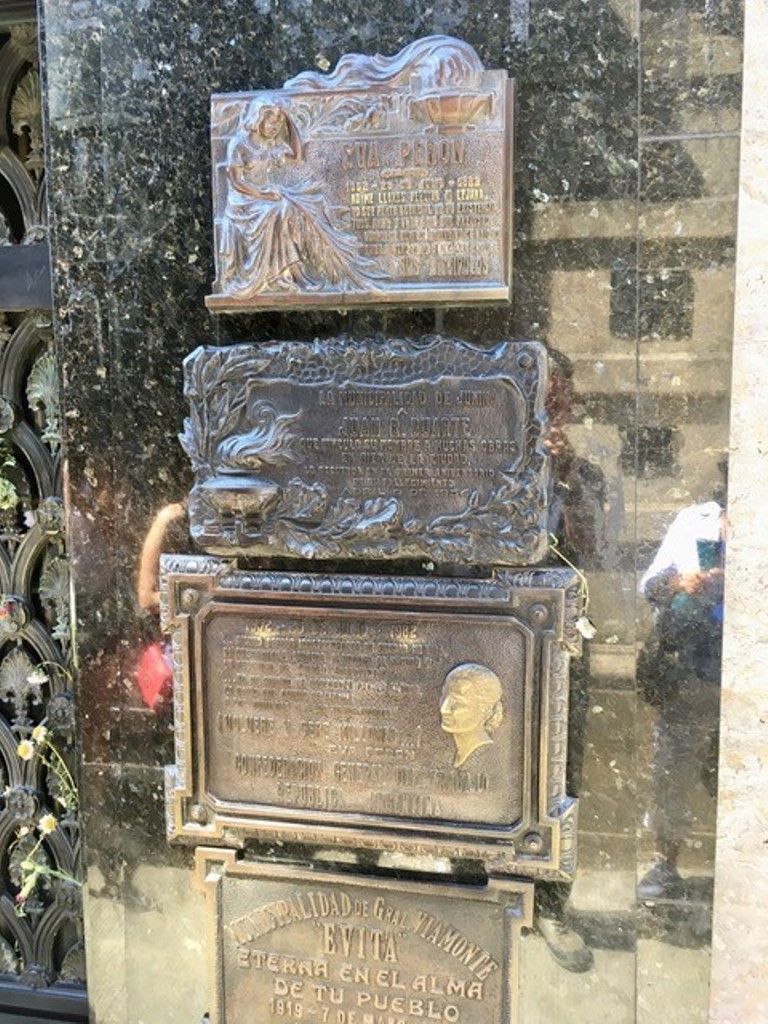
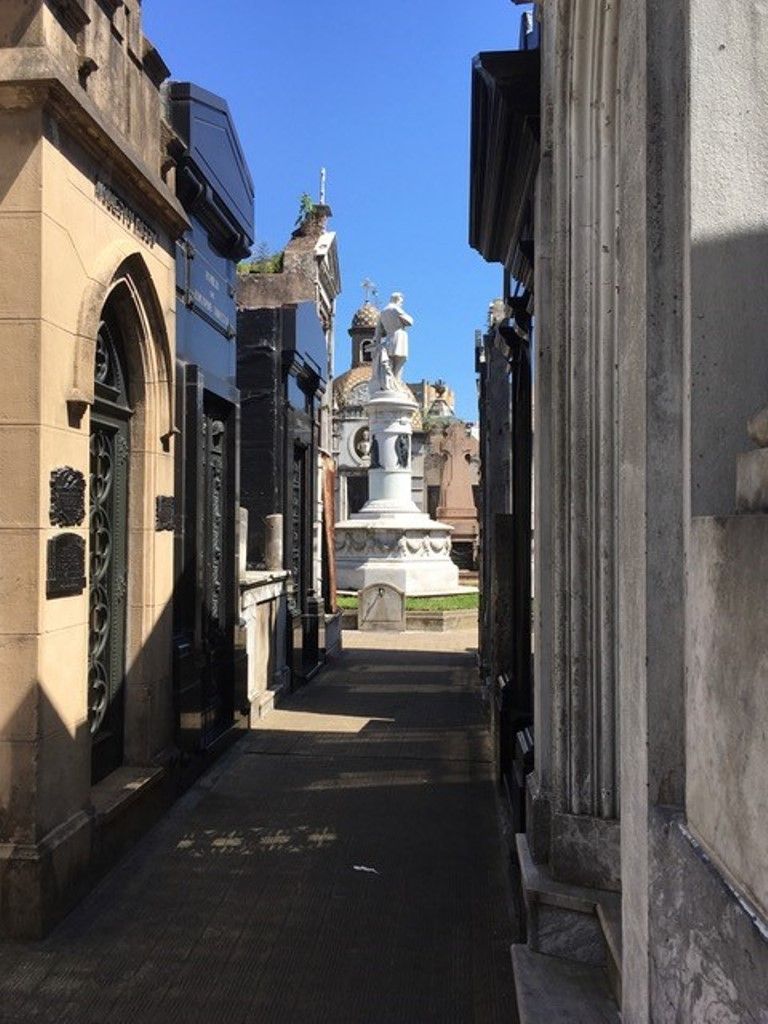 On our way back to our hotel we drove up the Avenue 9 de Julio, we were told by our guide that at 140 meters in width it is the widest street in the world, and was named in honour of Argentinas Independence day in 1816. The obelisk at the halfway point along the avenue was built to commemorate the 400th anniversary of the founding of the city, it was here that the avenue was blocked by some form of colourful political protest that drew the ire of our guide and forced us to detour, but for us it was a fleeting glimpse of another facet of this vibrant city. I had the chance after lunch at the hotel to walk the docks of the old port before we took a cab to join the ship, identical in most respects to the Azamara Journey and the Azamara Quest, so for us it was almost like coming home.
On our way back to our hotel we drove up the Avenue 9 de Julio, we were told by our guide that at 140 meters in width it is the widest street in the world, and was named in honour of Argentinas Independence day in 1816. The obelisk at the halfway point along the avenue was built to commemorate the 400th anniversary of the founding of the city, it was here that the avenue was blocked by some form of colourful political protest that drew the ire of our guide and forced us to detour, but for us it was a fleeting glimpse of another facet of this vibrant city. I had the chance after lunch at the hotel to walk the docks of the old port before we took a cab to join the ship, identical in most respects to the Azamara Journey and the Azamara Quest, so for us it was almost like coming home.
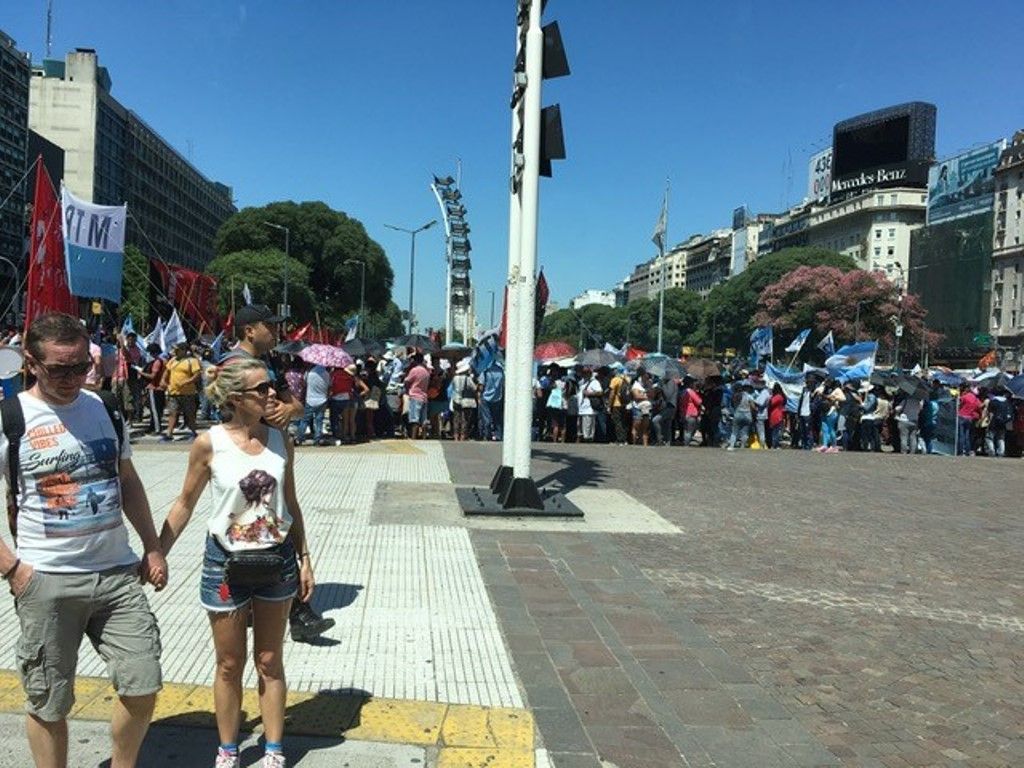
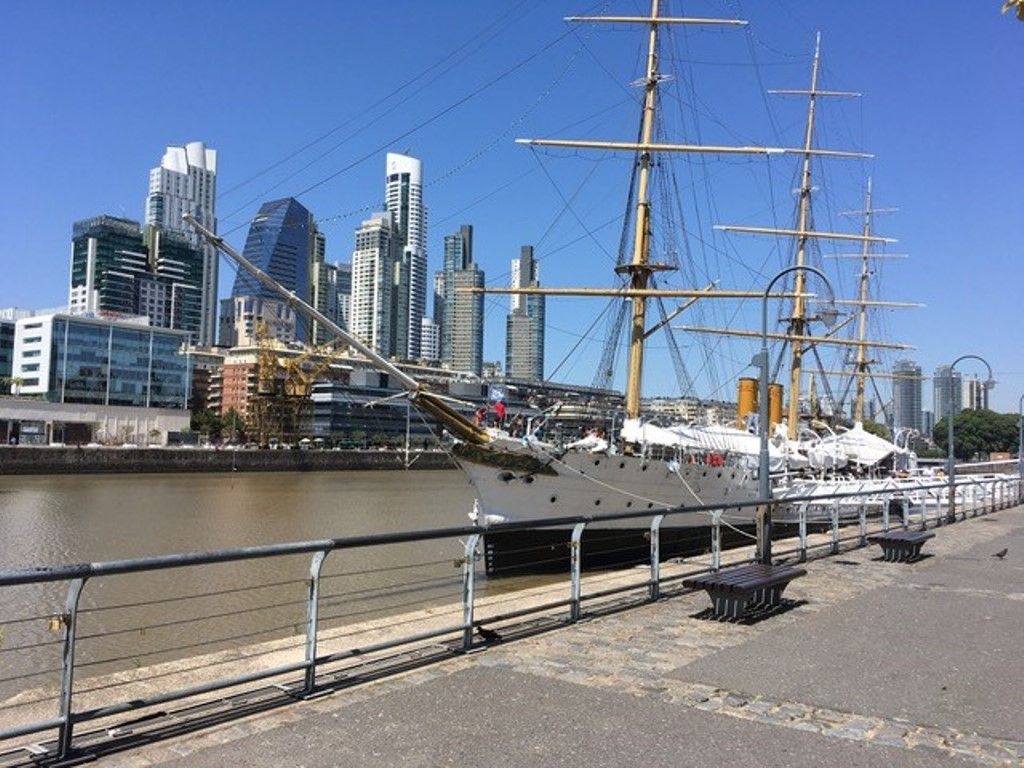 It didn’t take long to reconnect with the Segals, and 6 others who had been with us on the World Journey in 2018, again it was like old times.
It didn’t take long to reconnect with the Segals, and 6 others who had been with us on the World Journey in 2018, again it was like old times.
We sailed at 5 for Punta del Este in Uruguay 180 miles across the River Plate, which in actual fact is not a river but a delta formed by several rivers flowing into the Atlantic Ocean, at its mouth it is 143 miles wide, Punta del Este being at the eastern extreme and the southern most point of Uruguay.
Tuesday, March 3rd. Punta del Este.
We anchored off Punta del Este at 8 in the morning after a calm crossing through the turgid brown waters of the Rio de la Plata, so named by the Spanish, the river of silver, as it was the major place in South America from which the Spanish shipped their plundered gold and silver in the days of the Spanish Empire.
Punta del Este is beach and holiday resort, mainly for Argentinians, it has a permanent population of around 10,000 which swells, unbelievably, to 500,000 during the summer vacation period. As a consequence it is a bit like the Gold Coast in appearance with high rise hotels and apartment buildings along the Atlantic coast beaches, including a Trump Tower under construction.
We were taken ashore by tender, in the harbour were massive sea lions feeding alongside the fishermens wharf where they were gutting their catch into the water. We joined a 3 hour cycle tour around the coast, our first stop at Uruguays most Southern point, nothing remarkable to see except that an anchor placed on a rock was the demarcation line between the River Plate and the Atlantic Ocean and it was off this section of the coast that the Battle of the River Plate took place in December 1939.
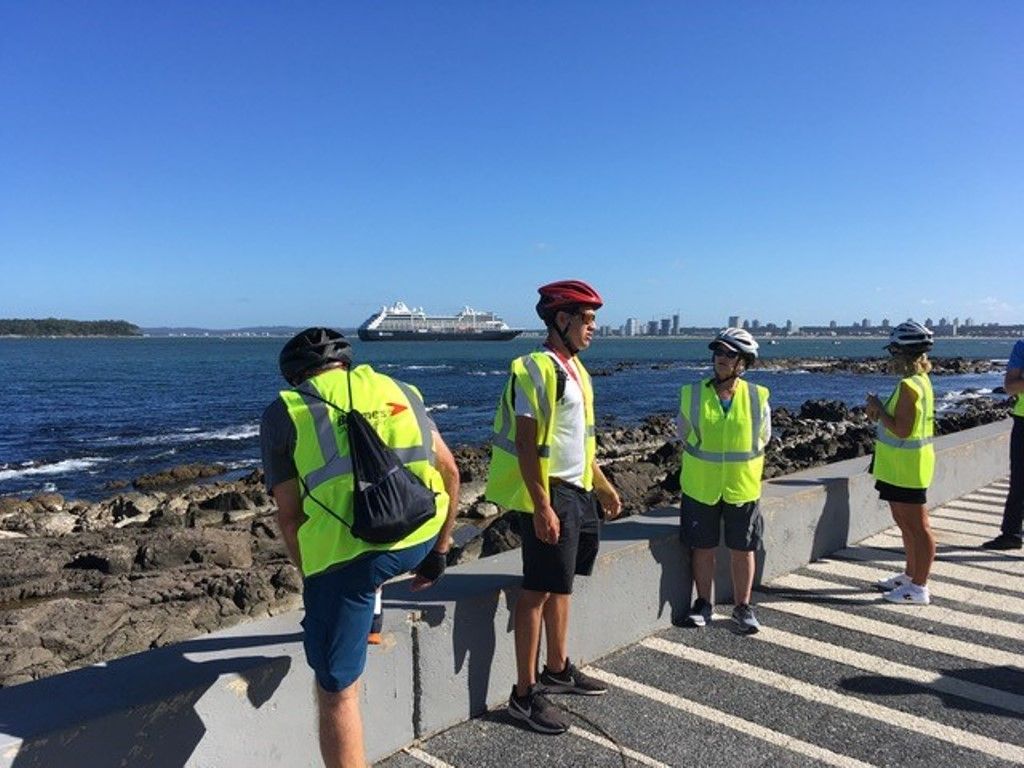
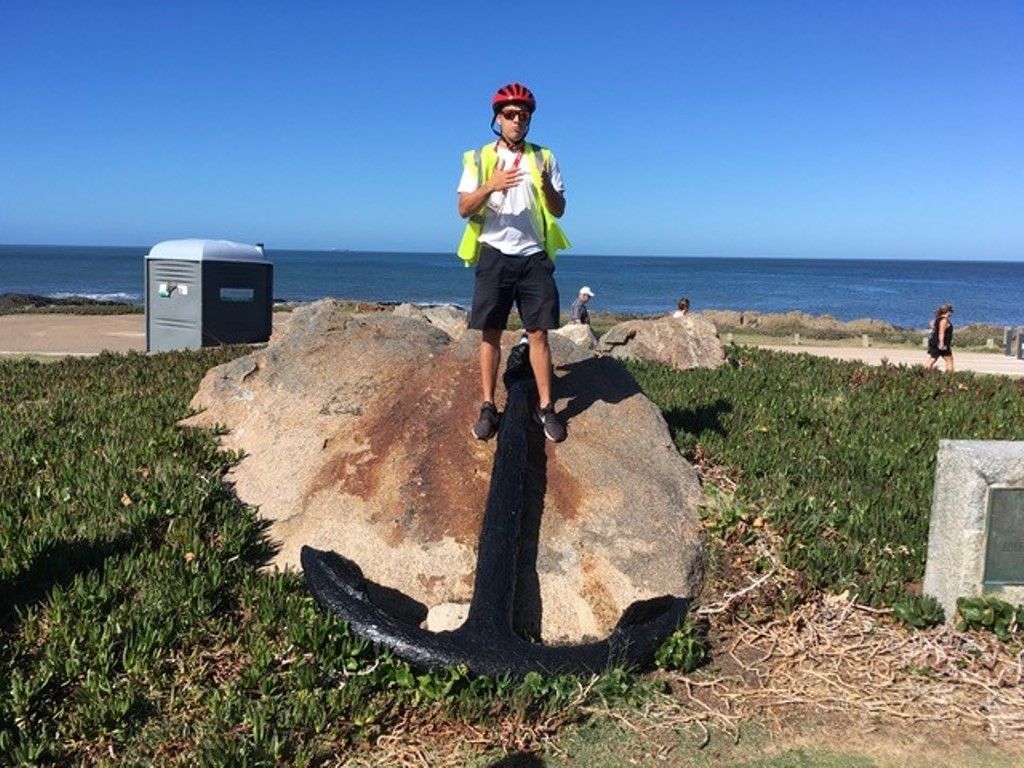 The German pocket battleship Graf Spee was caught by a Royal Naval flotilla including HMNZS Achilles, and iin the ensuing engagement inflicted such damage to the battleship that she sought refuge in the Bay of Montevideo. Refuge was denied by Uruguay who had historicallyenjoyed a close relationship with the Britishand she was ordered back to sea after 72 hours, in no fit state to sail anywhere let alone defend herself from what they believed was a large Royal Naval presence waiting outside. The Commander took the ship just outside the international waters of Uruguay just off Montevideo having landed all his captured British crews from the ships they had sunk, and all but a skeleton crew of his own, where they scuttled the ship to ensure that the British would not capture her and learn of their advanced range finding systems. 2 days later the Commander laid the Battle Ensign of the Graf Spee on the carpet of his hotel room and shot himself, rather than face the fate awaiting him in Germany where he had been branded a coward.
The German pocket battleship Graf Spee was caught by a Royal Naval flotilla including HMNZS Achilles, and iin the ensuing engagement inflicted such damage to the battleship that she sought refuge in the Bay of Montevideo. Refuge was denied by Uruguay who had historicallyenjoyed a close relationship with the Britishand she was ordered back to sea after 72 hours, in no fit state to sail anywhere let alone defend herself from what they believed was a large Royal Naval presence waiting outside. The Commander took the ship just outside the international waters of Uruguay just off Montevideo having landed all his captured British crews from the ships they had sunk, and all but a skeleton crew of his own, where they scuttled the ship to ensure that the British would not capture her and learn of their advanced range finding systems. 2 days later the Commander laid the Battle Ensign of the Graf Spee on the carpet of his hotel room and shot himself, rather than face the fate awaiting him in Germany where he had been branded a coward.
Our beach front ride was made interesting by our young guide who gave us a few facts about Uruguay, added to later when Art searched out a lot more and shared them with us that evening back on the ship.It is the second smallest South American country, second only to Suriname. Its land area is roughly twice the size of Belgium,it borders Argentina to the west, and Brazil to the north and east, has a total population of 3.5 million, 1.8 million of whom live in the capital, Montevideo. Its history is one of continued foreign interference and occupation, only winning its independence in 1828 after Portugal, Spain, Argentina, Brazil, and the British all had a period of influence and governance.
Britains involvement came about as a result of the industrial revolution and a failed attempt to replace Spain as the predominant colonial power in South America. With Napoleon having successfully blockaded Britains ability to trade into Europe Britain had to search for other markets for the goods and services it had developed so saw South America as a region it could dominate commercially. It was assisted by Napoleons appointment of his older brother Joseph as King of Spain in 1808, a move which encouraged the independence movements of all the Spanish colonies who could not contemplate having a French King as their Head of State and rebelled. Uruguay, through the connivance of Lord Ponsonby, a British diplomat stationed in Buenos Aires to further Britains interests, was formed as a separate state, partly to keep the warring Argentineans and Brazilians separated by creating a land block but also to establish a greater commercial foothold in the region. Britain established railways throughout S. America, and was responsible for much of the infrastructure construction and institutional investment during the 19th Century, so what had not been achieved through political means was successfully put in place commercially.
Like Argentina Uruguay had an unstable political environment and guerrilla uprisings resulting in a coup involving the military in 1973, and suffered similar outcomes to Argentina on a lesser scale in the period up until 1985 when a civilian government was reinstalled.
Nowdays Uruguay sees itself through somewhat rose tinted glasses as ranked first in Latin America with respect to democracy, peace, low perception of corruption, press freedom, and on a per capita basis contributes more peace keeping troops to the UN than any other country, it is ranked 2nd in terms of economic freedom and income equality. 95 % of its electricity is from renewable sources, its economy mainly based around agricultural exports. It has also legalised cannabis. All this from Art and our guide, helped again by Dr Google and from one of our lecturers on board, an Englishman who has lived in Uruguay for over 40 years who gave an incredible illustrated address on the Battle of the River Plate.
To finish off Punta del Este, the beaches are of golden sand, and quite attractive, though nothing like what we enjoy at home, and the water temperature is only 17 degrees! They do have some interesting beach sculptures however, and it is obviously a popular destination, but it does make me reflect on how fortunate we are living where we do.
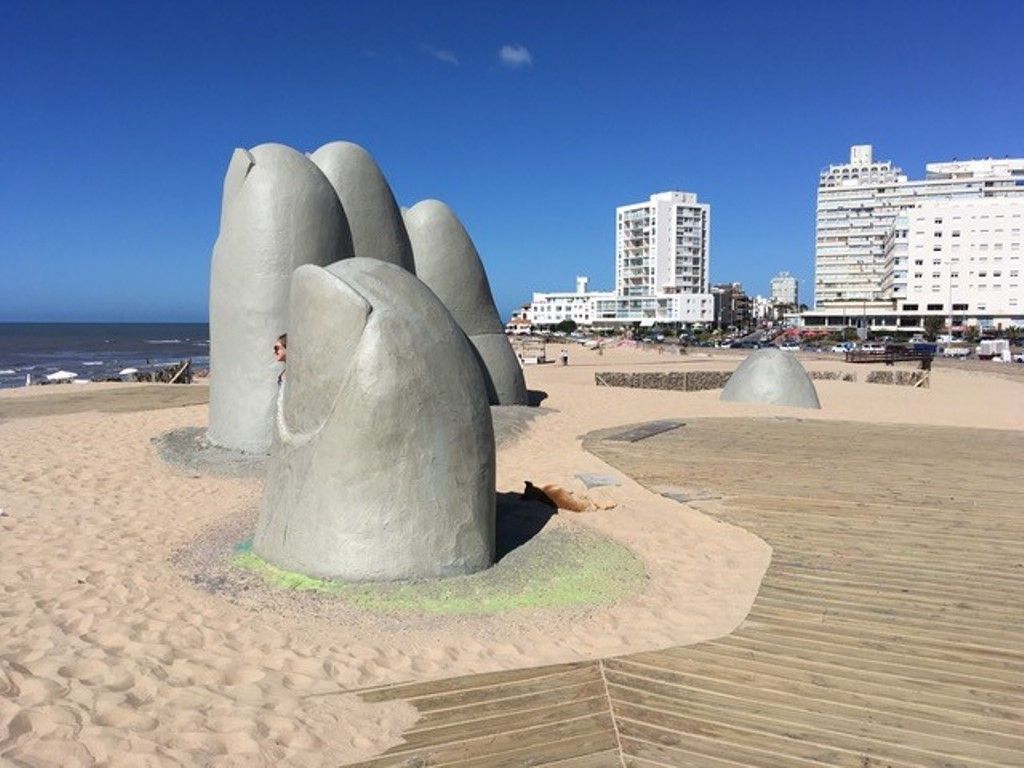 We sailed at 6.30 that evening for Montevideo, back up the Rio de la Plata another calm overnight voyage.
We sailed at 6.30 that evening for Montevideo, back up the Rio de la Plata another calm overnight voyage.
Wednesday March 4th, Montevideo.
Montevideo is sited in a natural bay within the Rio de la Plata and was founded as a military stronghold by the Spanish the early 18th Century although the Portuguese had preceded the Spanish and founded a colony at Sacramento in 1680 further up the coast of the Rio de la Plata, opposite Buenos Aires.
We took a walking tour of the old city of Montevideo, and as we walked off the pier past some nautical memorabilia, our guide recounted the story of the Graf Spee, and pointed out one of her anchors, recovered from the wrecked remains in 1974, and one of the range finders, the secret equipment that they didn’t want the British to see, recovered at the same time.
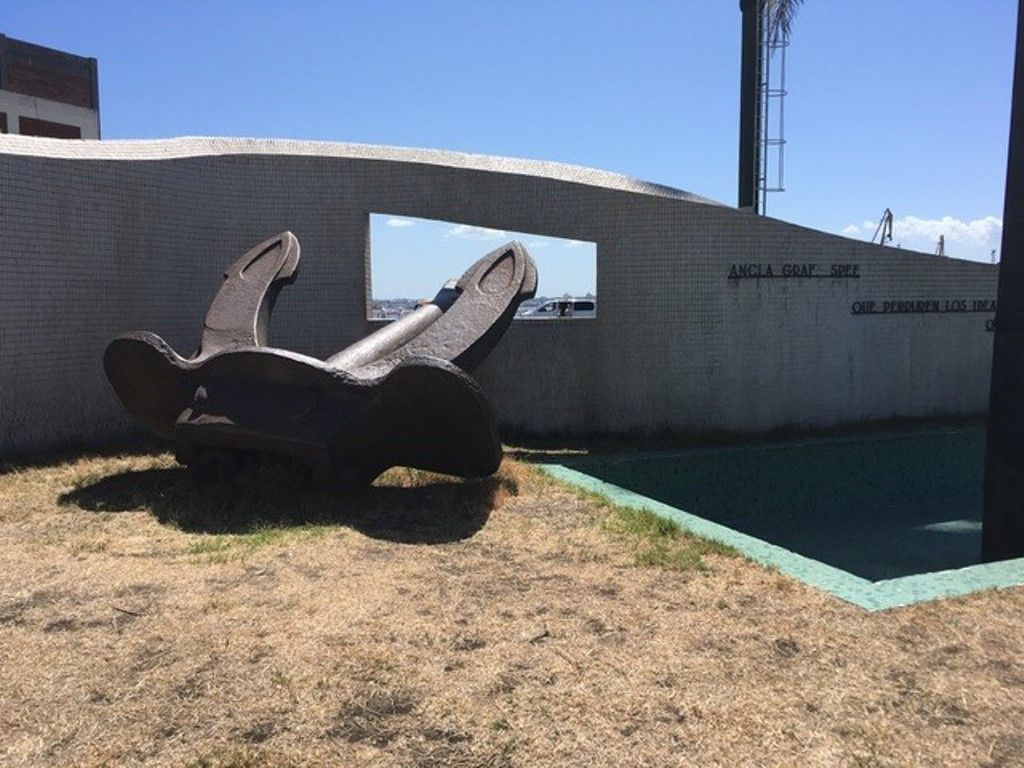
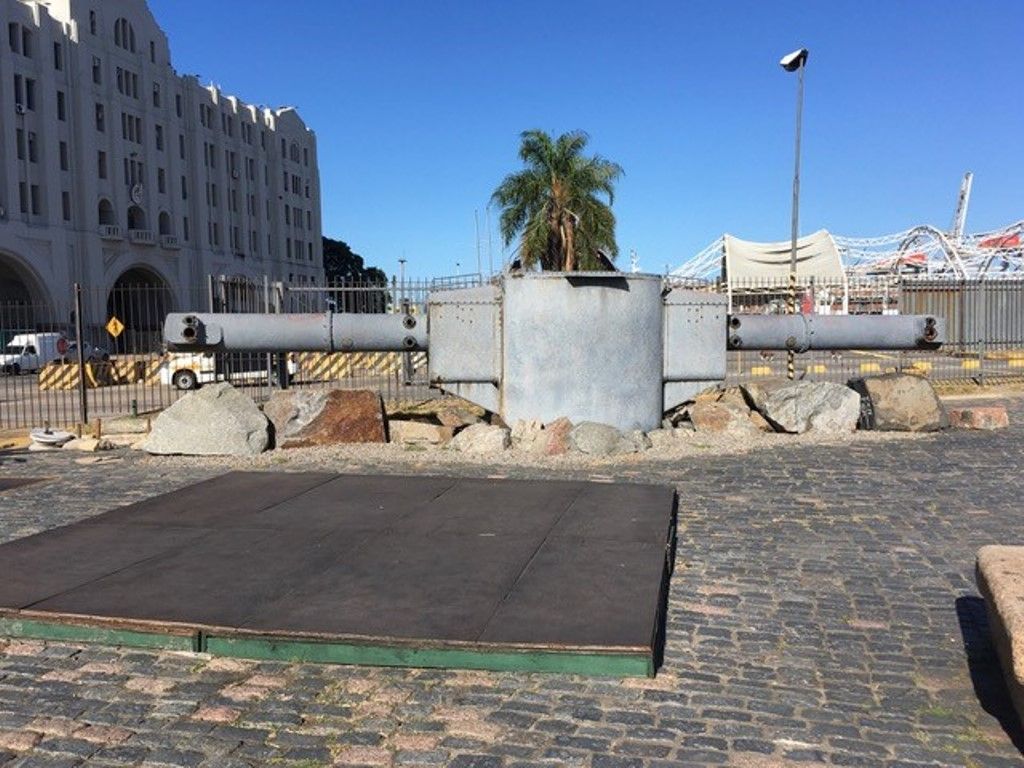 Our three hour walk was mainly focused around the influences on the architecture of the city that had arisen from the nationalities of the influential shakers and movers in the citys comparatively short history. The port and its natural harbour were a major factor in its development, the old city having been a walled Spanish fortified citadel, with the cathedral, and the Cabildo both sited on Constitution Square as the remnants of the Spanish period, along with one of the original gates that led into the citadel. The Cabildo was the seat of Government during the Spanish rule, and is now a museum, but importantly for Uruguay, it was where the constitution of Uruguay was declared and signed in 1830.
Our three hour walk was mainly focused around the influences on the architecture of the city that had arisen from the nationalities of the influential shakers and movers in the citys comparatively short history. The port and its natural harbour were a major factor in its development, the old city having been a walled Spanish fortified citadel, with the cathedral, and the Cabildo both sited on Constitution Square as the remnants of the Spanish period, along with one of the original gates that led into the citadel. The Cabildo was the seat of Government during the Spanish rule, and is now a museum, but importantly for Uruguay, it was where the constitution of Uruguay was declared and signed in 1830.
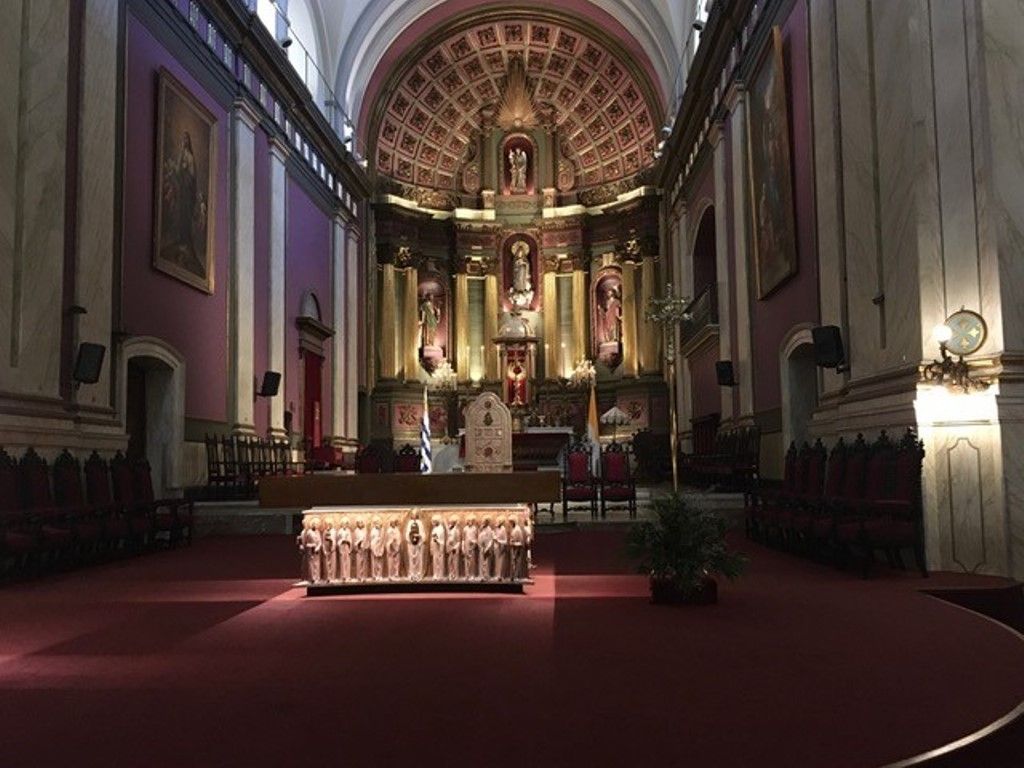
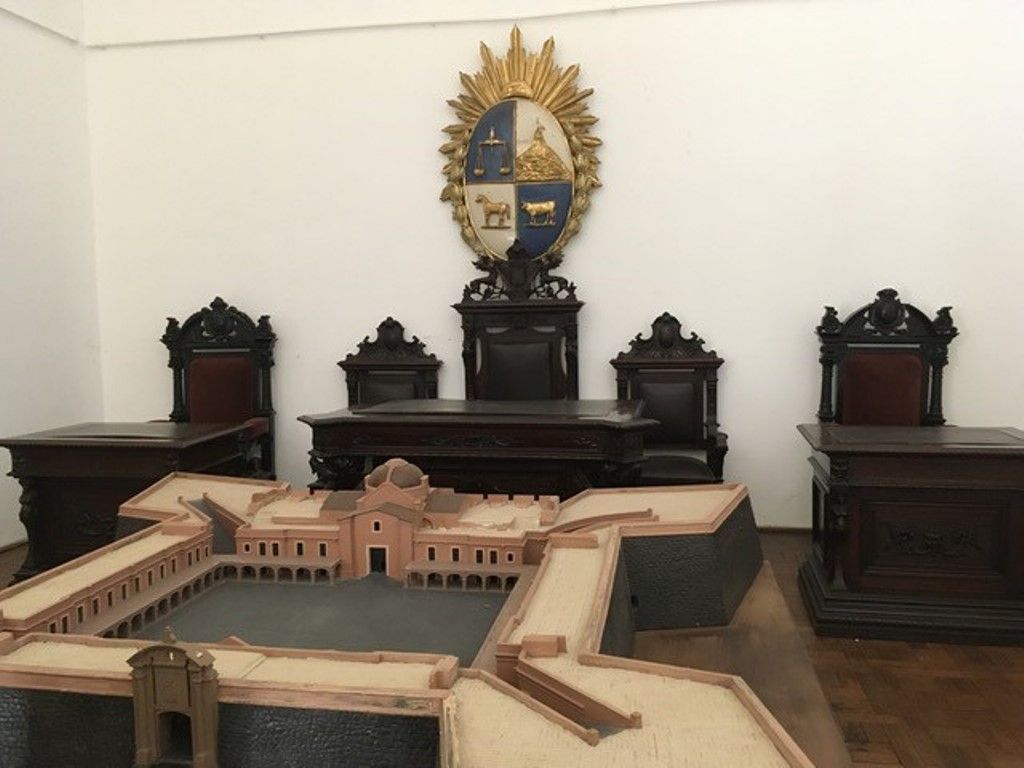 The above is a model of the Spanish citadel, sitting in front of the furniture in the Cabildo where the constitution was signed.
The above is a model of the Spanish citadel, sitting in front of the furniture in the Cabildo where the constitution was signed.
The other noticeable influences were the French and the English but unfortunately not many examples remain as prior to the 1970s many of the notable buildings were demolished, only now are such buildings protected.
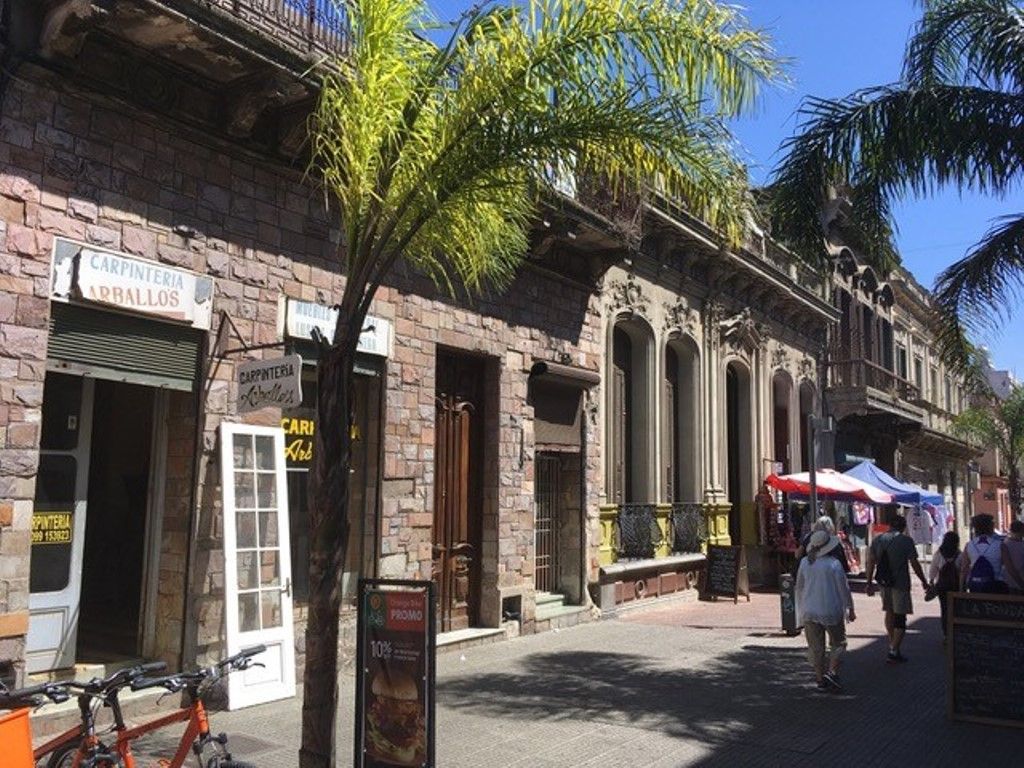 Our tour included a sampling of Uruguays national beverage mate, a herb based concoction drunk through a metal straw from a special rounded pot, shared with friends and family sipping from the same pot. Not what we would call a particularly palatable experience but obviously a very important part of their culture.
Our tour included a sampling of Uruguays national beverage mate, a herb based concoction drunk through a metal straw from a special rounded pot, shared with friends and family sipping from the same pot. Not what we would call a particularly palatable experience but obviously a very important part of their culture.
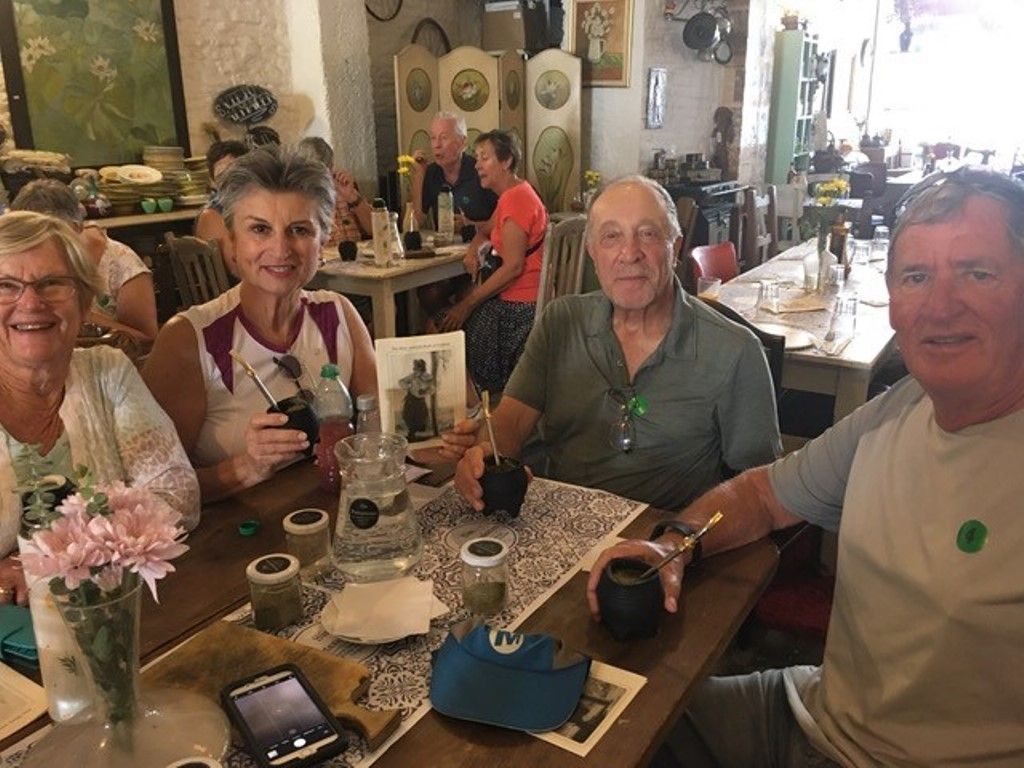 The old city ends where the wall of the citadel once stood, beyond the remaining gate lies Independence Square with the old and new presidential buildings, side by side, unfortunately not accessible due to the inauguration ceremony only a couple of days previously of the incoming President.
The old city ends where the wall of the citadel once stood, beyond the remaining gate lies Independence Square with the old and new presidential buildings, side by side, unfortunately not accessible due to the inauguration ceremony only a couple of days previously of the incoming President.
Our last stop was the old Port Market,a structure brought in from Liverpool in the 1870s sited down next to the port and now occupied by restaurants featuring Uruguays wood fired barbecues .Massive steaks of all cuts and sizes, a place with real atmosphere and somewhere that I wish we had made time to eat in!
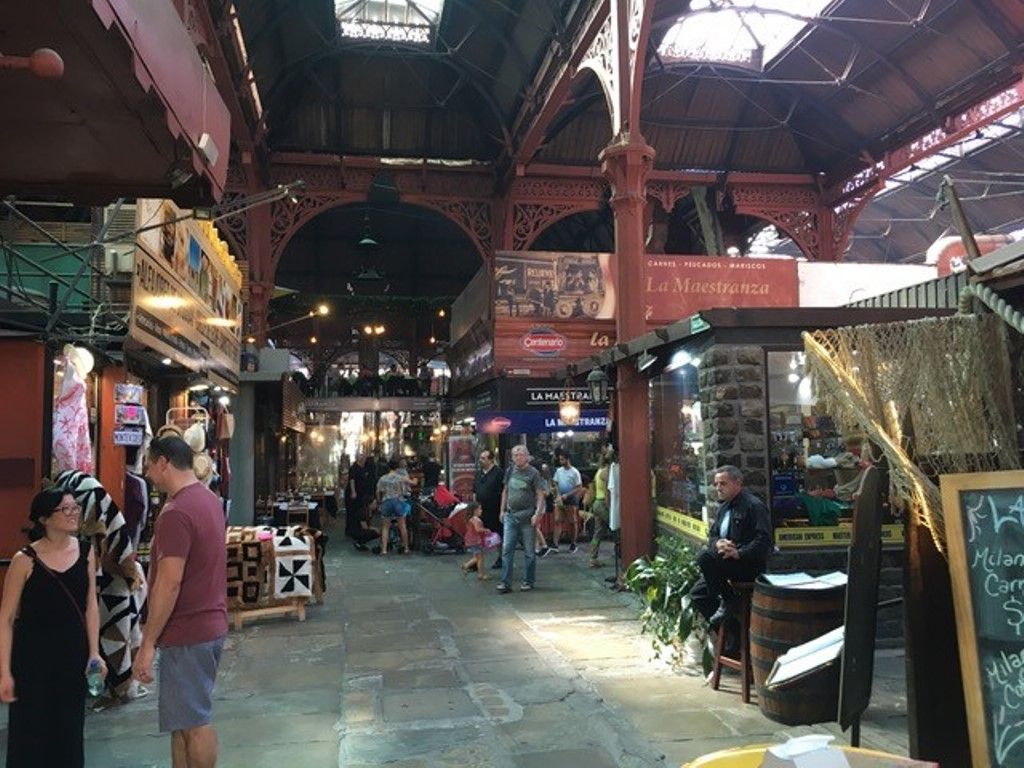
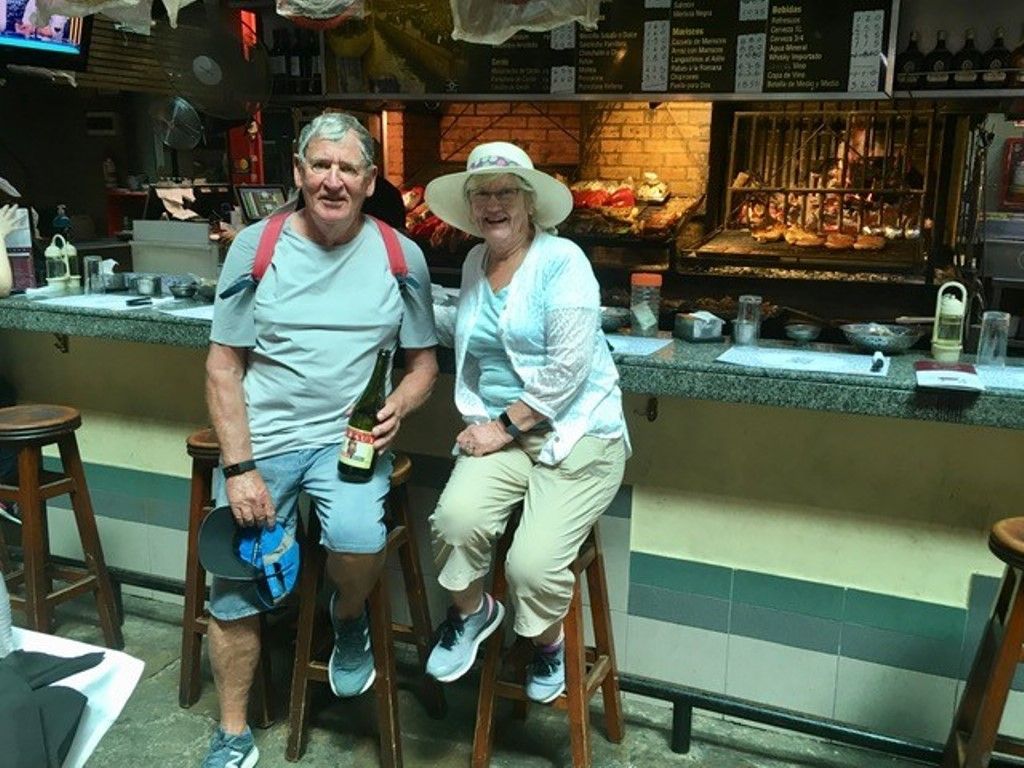 In the afternoon I went back ashore to check out a couple of museums, one of which was an opulent mansion built for a successful Spanish farming family, the other the Cabildo, but while we found the walking tour worthwhile I would have to say that as a city Montevideo was not one of the most memorable places we have visited. I did however come across an interesting piece of graffiti, reflecting a dim view of Trumps relationship with South America.
In the afternoon I went back ashore to check out a couple of museums, one of which was an opulent mansion built for a successful Spanish farming family, the other the Cabildo, but while we found the walking tour worthwhile I would have to say that as a city Montevideo was not one of the most memorable places we have visited. I did however come across an interesting piece of graffiti, reflecting a dim view of Trumps relationship with South America.
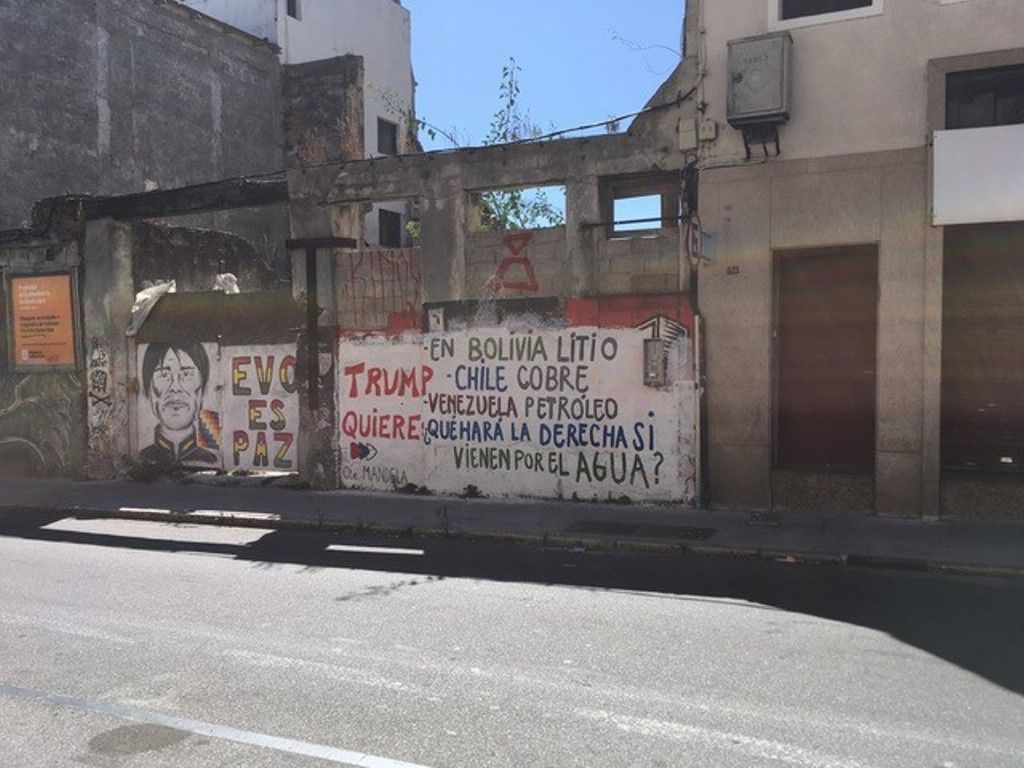 The highlight of our time in Montevideo was still to come.
The highlight of our time in Montevideo was still to come.
That evening we were all taken to Teatro Solis, an incredible theatre, for an Azamazing evening of celebration a la Carnivale.
On every cruise Azamara puts on one of these spectacular occasions for all on board, you may recall us talking about them in the past, such as the string ensemble playing classical music in the Roman Theatre in Ephesus.
Well this one was exceptional, a colourful presentation of the spirit of the Carnivale, Uruguay style. The costumes, the music, the dancers, the drummers, the joy of it all, a truly wonderful evening, we felt spoilt. I will include some photos it in the next newsletter, at the moment I can’t transfer them from my phone to the computer for some reason.
Sunday March 8th, at sea, east of Tierra del Fuego.
We are due in Ushuaia tomorrow morning, our three days at sea from Montevideo have been interesting, to say the least.
We sailed from Montevideo at 2pm on Thursday, after a really special reunion with Annie and Mike Gallagher, from Wilmington, Delaware, travelling companions on the World Journey in 2018 who just happened to have arrived in Montevideo that morning on an Oceania cruise ship, the Insignia, a sister ship of the Azamara vessels. They are on another world cruise and serendipity played its part in having us all meet up, the 10 of us from our ship and them, on the wharf at a dockside cafe, it was as if we were still on the World journey, and an absolute joy to reconnect.
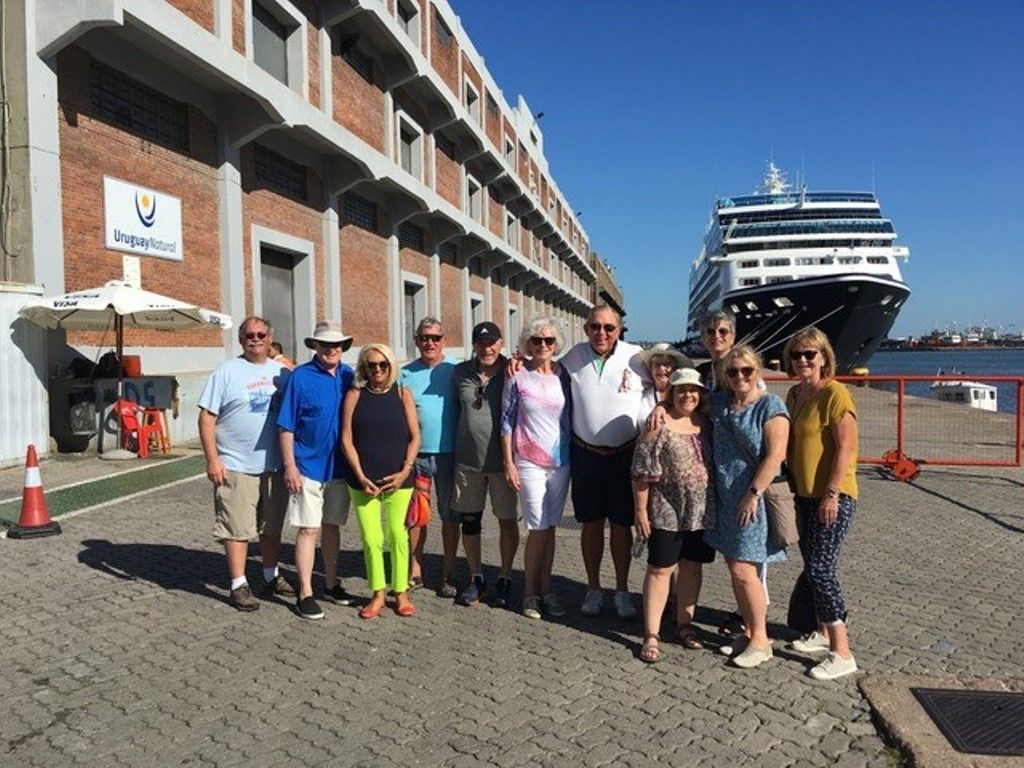 An uneventful sailing from Montevideo back down the Rio del Plata before turning south down the Argentinean coast, waking on Friday morning to calm seas and thick fog which didn’t clear til evening, all day the mournful blast of the foghorn sounding, but time to get back into an at sea routine. Unfortunately the weather forecast for the next 2 days was not encouraging and as it so happened Saturday we woke to strong winds and a rising sea and swell, such that by mid morning all decks were closed off and the public rooms on the upper decks also out of action. in light of the forecast the ship was diverted off its planned course to sail closer to the coast to try to seek some shelter from the wind of 40 knots off the land and a swell of about 4 metres. The strategy worked such that the ships motion was reduced to a bearable buffeting and the stabilisers kept the ship fairly steady.
An uneventful sailing from Montevideo back down the Rio del Plata before turning south down the Argentinean coast, waking on Friday morning to calm seas and thick fog which didn’t clear til evening, all day the mournful blast of the foghorn sounding, but time to get back into an at sea routine. Unfortunately the weather forecast for the next 2 days was not encouraging and as it so happened Saturday we woke to strong winds and a rising sea and swell, such that by mid morning all decks were closed off and the public rooms on the upper decks also out of action. in light of the forecast the ship was diverted off its planned course to sail closer to the coast to try to seek some shelter from the wind of 40 knots off the land and a swell of about 4 metres. The strategy worked such that the ships motion was reduced to a bearable buffeting and the stabilisers kept the ship fairly steady.
However overnight the forecast bad weather hit, with the wind gusting up to 65 knots and a swell of 6 metres, at times slowing the vessel down to 6 knots, several course alterations during the night to minimise the battering. By dawn we were close enough to the coast to have gained some shelter with the swell on the beam and although the wind was still at 45 knots we were able to increase speed once more as we headed south. The good news is that the forecast is for the wind to drop to 20 knots by evening and be calm tomorrow for our arrival in Ushuaia. The crew have been amazing through these trying conditions coping with keeping us fed and watered without complaint, and the ship has shown her seaworthiness in unpleasant conditions, the temperature has now dropped down to 12 degrees, so it will be fresh when we venture ashore tomorrow.
I will endeavour to get this away once we arrive, as usual I am having fun with the internet but that should resolve itself tomorrow.
Until the next, take care,
Jon and Bev

